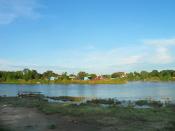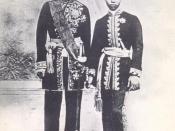It is difficult to determine the type of culture which existed in Thailand before the Christian era, since no written records or chronologies exist but archeological excavations in the area north of Nakorn Ratchasima indicate that there were people living here over 4000 years ago.
However, by the 6th century AD thriving agricultural communities were established from as far north as Lamphun to Pattani in Southern Thailand. Theravada Buddhism was flourishing, and probably entered the region around the 2nd or 3rd centuries BC when Indian missionaries were said to have been sent to a land called "Suvarnabhumi". (An area comprising Burma, Central Thailand and Cambodia).
The Dvaravati period, a loose collection of city states, centred around the Nakhon Pathom area, and lasted until the 11th century when it quickly declined under the political domination of invading Khmers.
During the 12th century A.D. and is set on top of Phanom Rung Hill in Ta Pek in the Chaloem Phra Khiat District of Buri Ram province which is the location of a long extinct volcano.
Phanom Rung is the original name and is mentioned in stone inscriptions excavated at the area. It is a religious site dedicated to the God Shiva, the supreme Hindu deity. It symbolises Mount Kailasa, the heavenly abode of Shiva.
During the 13th century several Thai principalities in the Mekong valley united and took Haripunchai from the Mons and the Sukhothai area from the Khmers. The Sukhothai kingdom declared its independence in 1238 and quickly began to expand. At its height the kingdom stretched from Nakhon Si Thammarat in the south to Vientiane in Laos, and Pegu in Burma. Sukhothai is considered by most Thai historians to be the first true Thai kingdom. King Rham Khamhaeng, the second king of the Sukhothai era, organised a system of writing...


